Knowing what to put on a resume is crucial for making a good first impression on hiring managers.
Most recruiters skim through new resumes for as little as 6-7 seconds, which limits your time to impress them. They also use an ATS, which scans resumes and lets only the relevant ones pass. That's why it's important to use the right keywords and divide your resume into distinct parts.
If you aren’t sure what information your resume needs to contain, we’ve got you covered! Read through our guide to learn what to put on a resume to make a striking impression on recruiters!
Key Takeaways
The most important sections of a resume include personal information, a resume summary, work experience, education, and skills.
Tailor your resume to match the specific job requirements by listing your most applicable education details, skills, and achievements for the position you’re applying for.
Keep the resume brief and specific. One page will be enough in most cases.
Avoid making up work history and achievements or using fluff words just to fill in your resume.
What to Put on a Professional Resume

If you want to figure out precisely what to put on a resume, here’s a list of the essential sections it should contain:
Mandatory Resume Sections
Personal information. This section features your name and contact information, letting the recruiters know who you are and how they can reach out to you.
Resume summary. This part of your resume contains 2-3 sentences that describe your professional career. It’s the first thing recruiters will see, so it needs to be impactful and highlight your best skills and accomplishments.
Work experience. Work experience directly tells the recruiter how good you are at doing your job. It’s the section they’ll spend most of the time on, which makes it a vital part of a professional resume.
Education. Along with your work experience and skills, the education section paints a picture of your competence and features your academic achievements. The less work history you have, the more important this part will be, but it’s also significant even when you have extensive work experience.
Skills. Hard and soft skills make you good at your job and are mandatory on every resume.
Additional sections. Depending on the position you’re applying for, you can also include some additional information in your resume. This may include your driving license, language proficiency, hobbies, interests, memberships at various groups or clubs, and more.
#1. Personal Information on a Resume
Putting your personal information at the top of your resume seems like a no-brainer, but there are still a few more rules to follow.
The first thing you want to do is list your full name. The usual format is “First Name, Last Name,” and the font size should be significantly larger than the body text to make it stand out.
Right underneath it, you should state your professional title. If possible, you should adapt it to fit the position you’re applying for. For example, there is a big difference between being a copywriter and content writer. For this reason, you need to make it clear what exactly you do.
Next up on the list should be a professional email address. Don’t use an unsuitable email address you made back in high school. If necessary, create a new one—something along the lines of johnsmith@gmail.com seems much better than n1njag4mer@hotmail.com.
The last bit of essential personal information is your phone number. The best practice is to include your country's code, even if you’re not applying for a job outside your country. It looks professional and gives all the necessary information the potential employer may need.
After all that, you can list your relevant social media handles, blogs, or websites. For example, in some cases it’s acceptable to add the links to your Twitter or Instagram handles or YouTube channels to a resume. This is especially useful if you’re applying for a social media-related job.
Here’s an example of a clean and minimalist personal information section:

And here’s another example with different formatting and a website included:
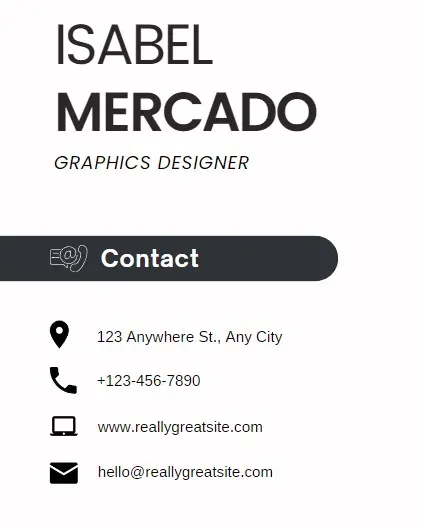
Should You Add a Picture to Your Resume?
Whether you should or shouldn’t insert a picture in your resume depends on the country where you’re looking for a job. In certain parts of Europe, for example, a resume photo is common, as it makes your document more memorable for hiring managers.
However, the situation in Canada, the US, and the UK is completely different. In these countries, your resume will probably get discarded if you put a picture in it. There are discrimination lawsuits that potential employees need to steer clear of. Even modeling resumes should be without photographs—instead, you should add relevant pictures to your portfolio.
These laws are also applicable to sensitive information, such as your age, marital status, gender, and nationality. It’s best to leave all these details off your resume on the basis of non-discrimination.
#2. Resume Summary or Resume Objective
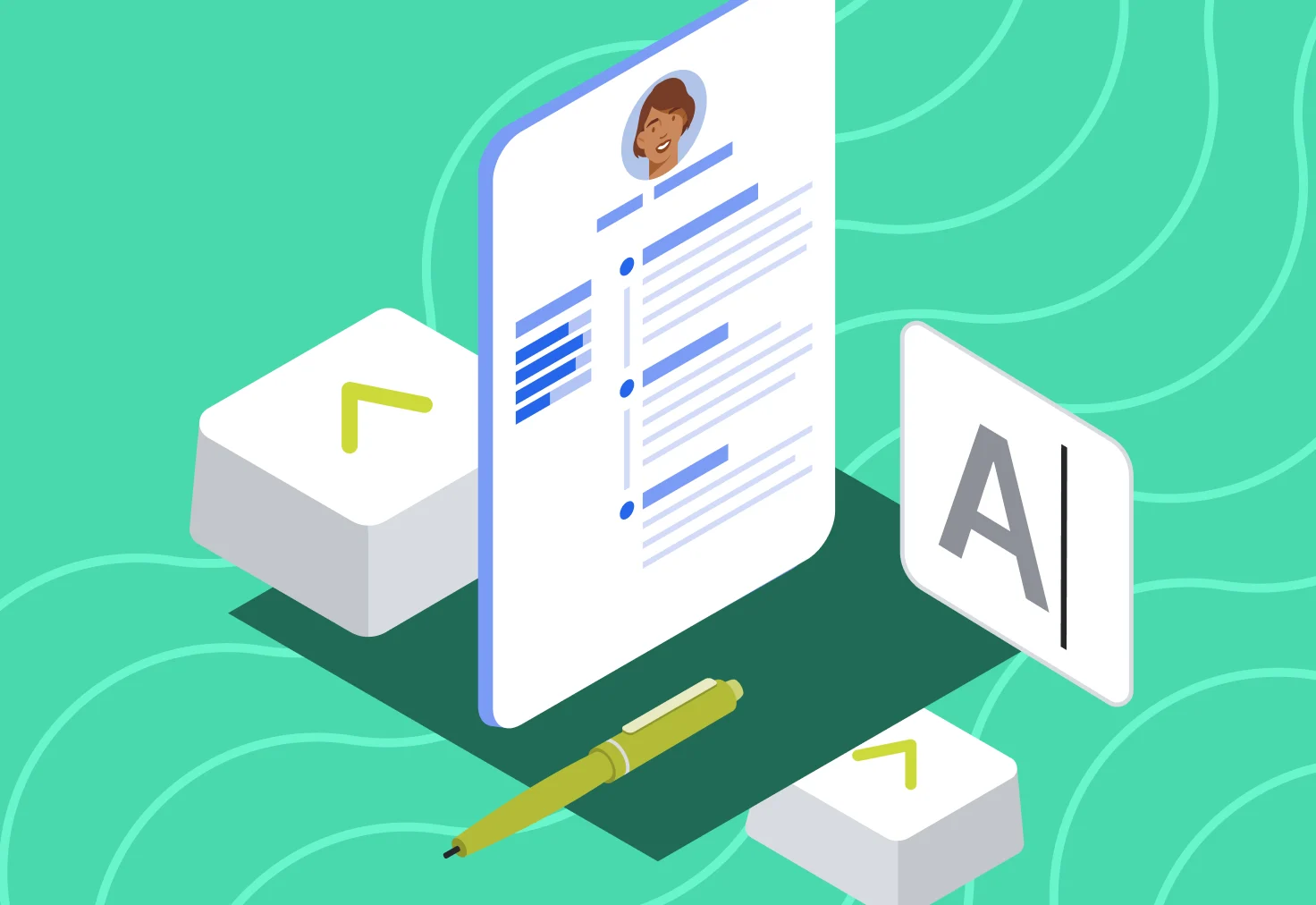
Depending on the amount of the professional work experience you have under your belt, you’ll either have a resume summary or a resume objective at the top of your resume. Let’s explain what the difference between these two sections is and what you need to include in them.
Resume Summary
A resume summary has a self-explanatory name. It summarizes the document, giving hiring managers an idea of what to expect when reading the rest of it. This section belongs at the beginning of your resume, and it should be just 2-3 sentences long but packed with high-quality, captivating information.
A resume summary is an opportunity to introduce yourself to recruiters in the most effective way possible. You only get one chance to make an excellent first impression, which is why this section needs to be impeccable.
You should highlight your best, most relevant qualifications, skills, and achievements in these few sentences. Their point is to make the recruiters believe that you’re the right candidate for the job before they even read the rest of your resume.
Another important step is to tailor every single word of your resume summary to fit the position until it spells, “I’m perfect for this job.” Use suitable action verbs and power words to stand out from the competition. Also, using numbers to quantify your performance is an excellent way to emphasize your value.
Here’s an example of a good resume summary:
Correct Example
“Results-driven professional with 5+ years of social media and email marketing experience. Personally created and grew an Instagram page to 10,000+ followers in under six months. Proficiency in content writing for high-end clients like Bloomberg, Financial Times, and more.”
Resume Objective

What to put on a resume if you want to create an impactful introduction but don’t have relevant work experience to feature? In that case, instead of a resume summary, you’ll write an enthusiastic resume objective!
A resume objective is similar to a resume summary in many ways. Both of these sections sit at the beginning of a resume. They should both have 2-3 sentences of highly effective and condensed information to attract hiring managers to take a further look at your resume.
Yet, while a resume summary is usually a better choice, there are two cases when you should use a resume objective instead:
When to Use a Resume Objective
If you’re applying for your first job and you lack professional experience, you won’t be able to create a work history-related resume summary. In that case, you’ll greatly benefit from displaying your willingness to learn and grow in the specific company by creating a captivating resume objective.
If you’re switching careers, you probably don’t have much work experience in the industry you’re transitioning to. If that’s the case, you should focus on your skills and achievements that can be relevant to the job you’re applying for now.
Here’s an example of what an enticing resume objective should look like:
Resume Objective Example
“Freelance content writer looking to transition to the SEO Specialist position. Has 5+ years of experience working with various clients, doing everything from keyword research and text quality assurance to customer relations. Excellent analytical skills and attention to detail. Proficient in Excel and word processing software.”
#3. Work Experience Section on a Resume
After you’ve successfully grabbed the hiring manager’s attention, they’ll look into your work experience section. From that point forward, this will be the most important part of your resume, which is why you want to make sure that every aspect of it is on point.
Here’s an example of what an elegant and functional work experience section looks like:
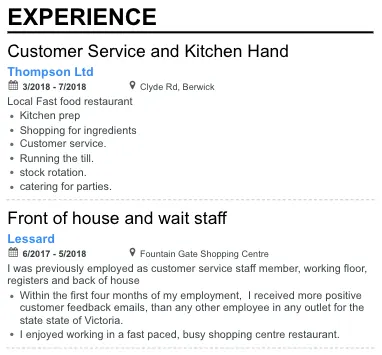
Format
Knowing how to list information is as important as knowing what to put on a resume. It's essential to format your work experience section correctly if you want it to look clean, professional, and easy to read.
For starters, use bullet points instead of blocks of text. Bullet points greatly improve readability and allow you to get the most information across while using the least number of words possible.
State the company name, the position you held there, and the start and end dates of your employment (preferably in months and years). There’s no need to go into too much detail here, so keep it brief.
One of the best ways to list your work history is to use the reverse-chronological resume format. Put the most recent employment first and go back from there. That way, recruiters will immediately see how your career has progressed over time.
Achievements
For every job position you showcase in your work history section, find one to three impressive achievements that you’ve obtained while you held it. These are incredibly powerful at showing accomplished results and giving hiring managers better insight into your abilities and productivity.
Be careful not to overdo it—don’t go for more than six achievements on your resume. You might lower the quality of this section, which could make the recruiters skip it altogether. Stick to those that are most effective and relevant to the job position you’re applying for.
Use relevant action verbs and power words to make this section more interesting and easy to remember. Also, insert exact numbers whenever possible to quantify your professional results. For example, "increased sales by 25% in the third quarter" sounds much better than merely stating that you "helped boost revenue."
No-Experience Resume
If you’re a student or a recent graduate, or if you are switching careers entirely, you might not have any relevant work experience to add to your resume. That doesn’t mean you should entirely skip the work history section.
So, what to put on a resume with no experience?
There are plenty of viable alternatives to write about that will make even a no-experience resume sleek and professional. Now is the time to use all of your college projects, roles in student organizations, volunteer experience, internships, and other useful experiences.
Talk about your accomplishments and relevant results. Also, highlight any skills that you’ve picked up along the way that would help you perform better at the company you’re applying to.
If you’re a recent college graduate, your education might be more important than your work experience, so you might want to change the order of the sections on your resume.
You should also consider making a functional resume instead of a chronological one. In this resume format, you list your most prominent skills first. Then, you use bullet points to list related accomplishments for each, backing them up with results.
#4. Education Section on a Resume

Your education section works in conjunction with your work history to best showcase your proficiency to the recruiter. That’s why, when deciding what to put on a resume, you should consider both of them equally.
If you have a rich and captivating work history, the education section should give it more room and come after it. On the other hand, recent graduates with no experience should leverage their education and put it at the top of their resume.
When it comes to your education section on your resume, there’s often not that much to it. You need to state the name of your university and its location, the degree you obtained, the enrollment and graduation year, and your major. Still, there are a couple of guidelines to help you ensure you get everything right. These will also help you in niche cases (when your education history isn’t clear-cut, for example).
Start your education section with your highest and most recent degree, or include the education that’s in progress. This way, the recruiter will know how far you’ve gone with your studies, even after a quick glance.
Point out your GPA, but only if it’s above 3.5. Also, if it’s a student’s resume, you should list any special projects, relevant courses, and academic honors you’re proud of. The same goes for extracurricular activities or study abroad programs.
Here’s an example of a professional-looking education history:
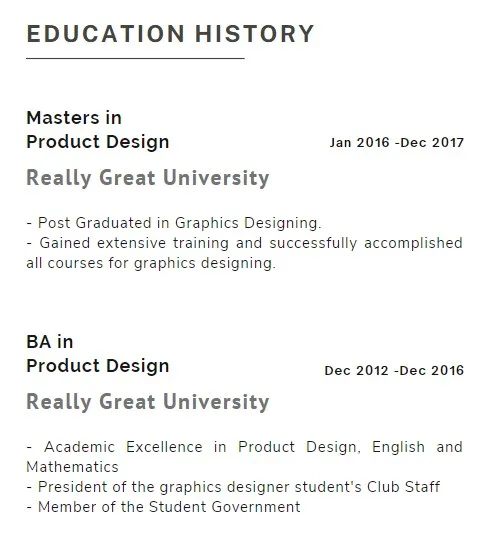
#5. Skills Section on a Resume

Alongside your work experience and education, relevant skills complete a picture of how good you are at doing your job. This makes them just as important as the previous two sections.
There are two types of skills you can list on a resume:
2 Types of Skills
Hard skills
Soft skills
Hard Skills
Hard skills are industry-specific and often highly specialized skills that enable you to do your job. They are acquired through formal education, programs, and courses or taught in universities and by using credible sources.
Hard skills are quantifiable and easily measured. A good set of hard skills is necessary on every resume, as it shows you’re capable of performing in the desired position. Employers evaluate proficiency in hard skills to determine whether to hire someone, give existing employees a raise or a promotion, etc.
When it comes to the hard skills you should mention on your resume, the choice depends on the industry you’re in and the job posting. For example, some of the most sought-after hard skills in IT are:
IT Hard Skills Examples
Coding
Machine learning
Cloud computing
App development
SQL
On the other hand, if you’re trying to land a job in business and finance, you might choose some of the following highly desired hard skills:
Business & Finance Hard Skills Examples
Accounting
Financial analytics
Administrative skills
Management skills
Investing skills
You should also know that hard skills are rarely transferable. Different careers or different positions within the same field often require diverse sets of hard skills. And, depending on your profession, they can be anywhere from moderately difficult to rather challenging to obtain.
Soft Skills
Soft skills differ from hard skills in many ways. They are non-technical, highly transferable, and applicable in many different careers. In fact, you can start honing them as early as during your school days!
Some of the most desired soft skills by recruiters are:
Soft Skills Examples
Interpersonal skills
Time management
Problem-solving
Listening skills
Soft skills aren’t industry-specific. They are rarely measurable but can have a big impact on your performance and workplace relations. Because of that, many employers pay extra attention to them. For example, you’re lacking in time management skills, you’ll probably end up underperforming even if you have impeccable hard skills.
Hiring managers are always looking for someone with remarkable soft skills, as they are more likely to fit in with the team effortlessly and overcome tough challenges when necessary.
Having that in mind, here are several more highly valued soft skills:
More Soft Skills Examples
Flexibility
Adaptability
Creative thinking
Leadership
Work ethic
Pro Tip
When listing hard and soft skills, it’s important to keep them in separate sections. Their applications are vastly different, so having them separate helps both with ATS and recruiters.
Universal Skills
While the difference between hard and soft skills is rather obvious, the line gets blurred when comparing soft skills to universal skills. This is because, in fact, universal skills represent a subset of soft skills.
As their name suggests, they are not merely highly transferable but also usable in any industry and any position.
When considering what to put on a resume when it comes to these skills, keep their relevance in mind. You could have a broad collection of universal skills, but you should only list those that are tightly connected to the job. For example, if you’re applying for a coding job, listing general computer skills that almost anyone possesses under the universal skills section is obsolete.
Here are some of the universal skills to put on a resume:
Universal Skills Examples
Creativity
Curiosity
Re-engineering skills
Critical thinking
Learning skills
#6. Other Sections to Add on a Resume

Besides your contact information and a resume summary, the big three (work history, education, and skills) make up the core of your resume. However, once the recruiter has seen them, they might be interested in learning more about you. These bonus sections can help you stand out and create a truly memorable resume.
Hobbies and Interests
If you’re looking for unique things to put on a resume, hobbies and interests are the way to go. They can give your document a personal touch and show what you’re like as a person outside of work.
Through hobbies and interests, you can also display ambition and drive, ability to learn, and eagerness to grow and improve. Also, having hobbies that are somewhat related to the position you’re applying for could be beneficial. Still, don’t be afraid to list something completely irrelevant as long as you’re passionate about it.
Here’s a creative way to show your interests:
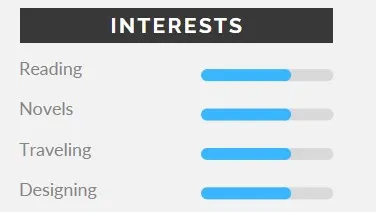
Publications
Relevant publications on your resume can be a powerful tool for impressing hiring managers. The best location for them is right after the education part. Use bullet points, list the year and the title, stick to the publications that show relevant proficiency, and your resume is guaranteed to stand out!
Courses
Courses are an excellent way to supplement your education section on a resume. You can add them at the bottom of that section or create an entirely new one.
Adding courses to your resume shows that you are always willing to learn new things and improve. They can help you stand out, fill in employment gaps, and show how you used your time off to improve instead of idling.
Certifications
Authorized organizations issue certifications to validate your proficiency in specific skills. In essence, they are proof of your abilities. Hence, you definitely want to list them on your resume to boost its quality.
The most common way to add certifications to your resume is to put them below your educational section. Make sure you include all the important information, such as the name of the certification and the agency issuing it, dates, and location (if applicable).
Here’s one of the multiple ways in which you can list certifications:
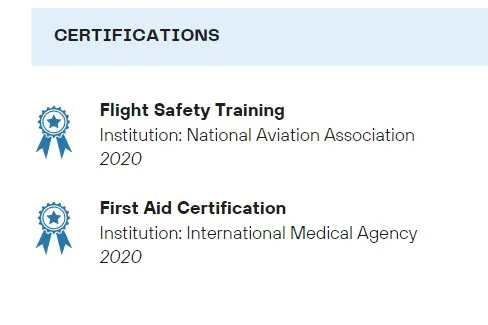
Projects
You can add projects to your resume to further highlight your accomplishments. They can go in the work history—under the job description, as achievements—or in a separate section.
If you’re creating a resume as a freelancer, the whole document can be project-based. Also, if you had no formal employment, you could list the most relevant projects to showcase your work history.
Volunteer Experience
Volunteer experience is often used in students' resumes and by candidates applying for entry-level positions. If you don’t have relevant work experience in the field, you should highlight your volunteer work, student projects, internships, and similar. Make sure they emphasize those skills and proficiency levels that the recruiters are looking for.
How to Tailor Your Resume to Match the Job Requirements
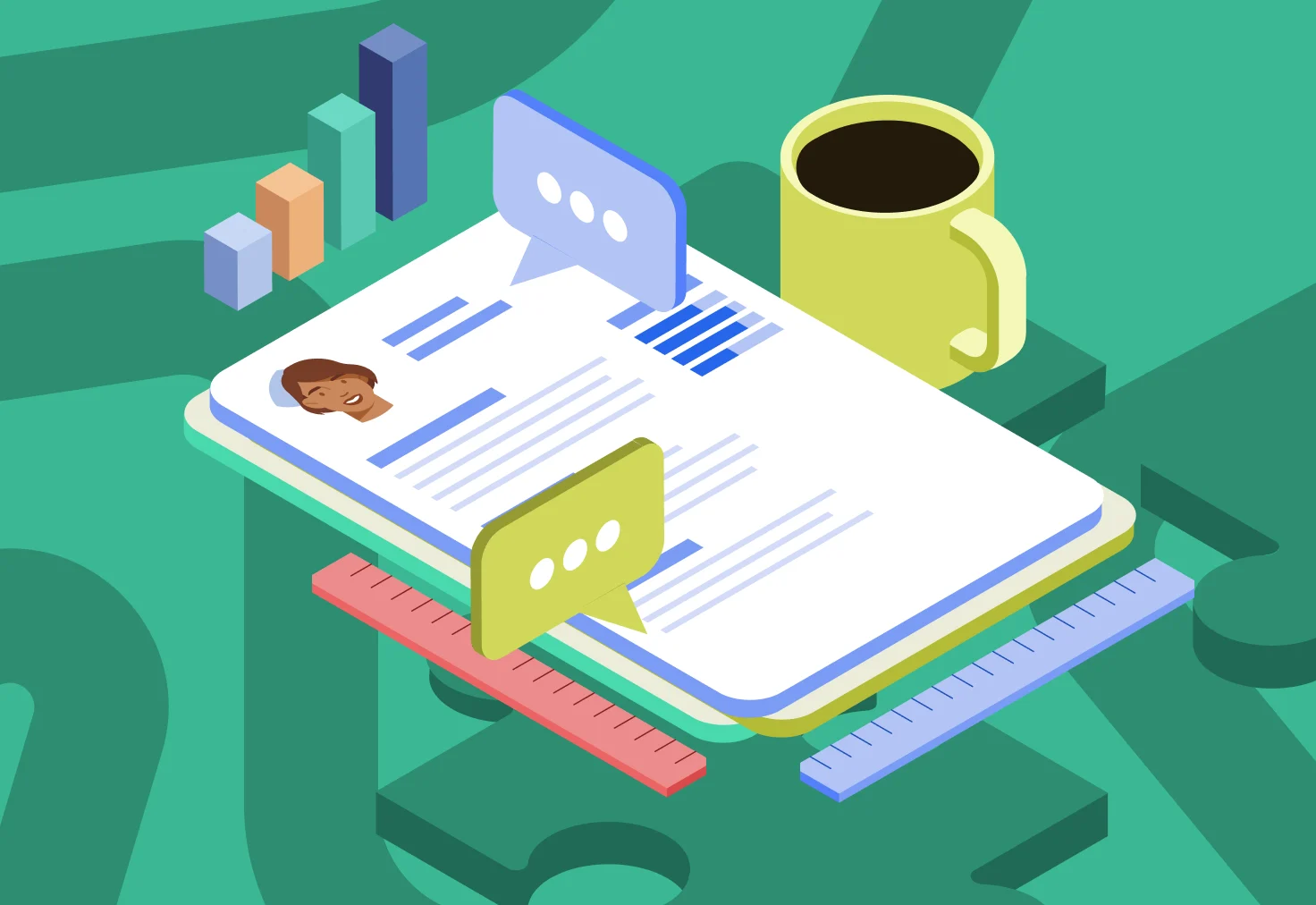
You could have the cleanest, catchiest, and most professional resume. Yet, if the information in it doesn’t match the job requirements, the recruiters probably won’t spend too much time reading it. For this reason, knowing what to put on a resume to tailor it to a job description is pivotal to landing your dream job.
When creating a resume, you should thoroughly study the job description you’re interested in. Figure out what they are looking for in a candidate. Which hard and soft skills would leave the best impression on hiring managers? Should you list your limited working proficiency in the German language? Do you squeeze in hobbies and interests or leave room for more important information?
Once you realize what the company is looking for, analyze your competencies and then choose the ones that meet the employer’s criteria. Of course, you need to be honest. If some of your skills, achievements, or certificates aren’t relevant to the desired position, just leave them out and come up with something else.
What Not to Include in Your Resume

Now that you know what to put on a resume, let’s take a look at the sections and information you shouldn’t include. It’s important to note that adding some of these pieces of information might hurt your chances with the recruiters or even get your resume discarded right from the start.
Personal Information
Oversharing personal information on a resume is an absolute no-no when it comes to creating a resume. While your phone number and city of residence are perfectly fine, you shouldn’t include the exact address.
Also, there’s no need to list every social media account you have. For example, if you’re applying for a back-end developer position, including your funny TikTok account to a resume probably isn’t the most professional move.
Summary or Career Objective
Your resume summary or objective should be all about what you can do for the company you’re applying to. The recruiters want to see your value and how they might benefit from hiring you.
Because of that, one of the biggest mistakes you could make is to write a salary expectation right at the beginning of your resume. Save the compensation discussion for the later stages of the interview process, and use this section to attract the recruiter’s attention first.
Work Experience
Creating the perfect work experience section is all about being concise and honest. Don’t include the jobs you had for a month or those that may be irrelevant to the job you’re applying for.
Similarly, don’t exaggerate your achievements or make numbers up. The recruiters will probably see through any insincerity, especially once you get to the interview and they start asking questions.
Education
It’s easy to go too far when describing your educational background on a resume. Only list your GPA if it’s higher than 3.5 and avoid mentioning your high school diploma if you have a BA, MA, or a higher degree.
On the same note, don’t add every single course you’ve attended to your resume. The goal is to be brief and to the point, so you should only add the relevant ones.
Skills
Figuring out what to put on a resume when it comes to skills can be tough with so many choices. However, the most important rule you should have in mind is that you mustn’t list skills that you don’t possess. As mentioned previously, you need to be sincere and mention only the ones you know you have.
Other Sections
Don’t go overboard with your hobbies and interests. While some recruiters may expect them or even encourage you to list them on your resume, you don’t want to spend more than a few lines on this part.
Also, make sure you choose something you’re truly passionate about. After all, if the recruiter starts a conversation about the topic, you need to hold your ground!
References Available Upon Request
This resume part is nowadays seen as unnecessary business jargon. Recruiters know they’ll receive references if they ask for them, so this is seen as a waste of space on your resume.
Length
Most resumes will be one page long and still contain all the necessary information. However, if you truly have an extensive work history or a lot of essential information to add, you could go for two or even three pages.
Other than that, keep everything as specific as possible. Don’t add irrelevant jobs you had for short periods of time decades ago, and don’t list too many unrelated skills, courses, certifications, etc.
Example of a Complete Resume
Let’s put everything that we’ve learned so far into practice and see what a good resume looks like. After all, that’s the best way to learn what to put on a resume—to see one in action!
Check out the following example to see how it’s formatted and how the sections are prioritized:
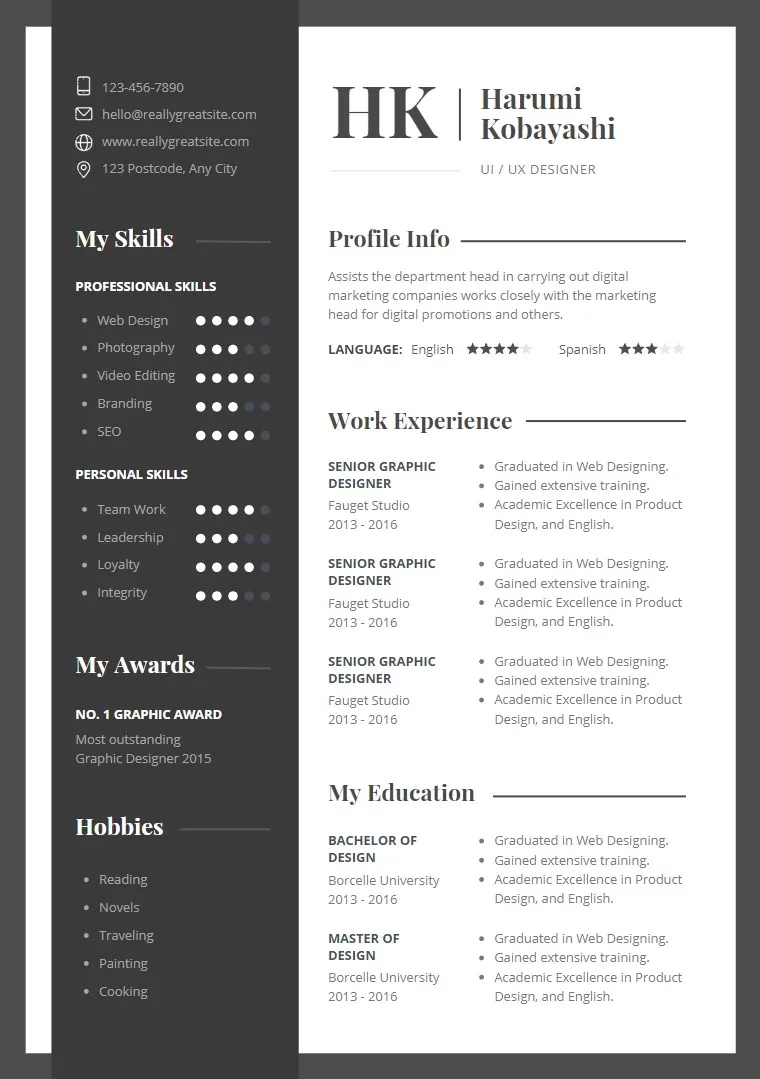
The very top of the resume features the candidate’s name and professional title. Next to it, we have all the relevant and necessary contact information.
The first section we get to is the “Profile Info,” which is basically the candidate’s resume summary. They took some creative liberty in listing language skills right underneath it. This could be useful if these are required by the company that posted the job ad they’re interested in.
The biggest part of the resume is the work experience section. It contains relevant achievements that the candidate listed by using bullet points. The education part comes next, formatted in the same way as work history.
The side of the document features all the relevant skills, and you can also notice how professional (hard) skills are separated from personal (soft) skills.
Finally, we have optional sections. One features awards, and the other is about hobbies, and these are absolutely enough to wrap the entire resume up.
Also, as you can see, there’s plenty of information in this resume, yet proper formatting and partitioning make it clean, readable, and professional!
Closing Thoughts
Figuring out what to put on a resume is not an easy task. That’s why we’ve given you all the necessary information and guidelines to help you create your resume from scratch.
You now know everything—from the ground rules of resume-making to the things you should avoid. Study the article thoroughly, and you’ll become a resume expert in no time. Your dream job awaits!
Related Articles
Top 99+ Resume Buzzwords to Use in 2025 [& Clichés to Avoid] Tips for Writing a Professional Resume Profile [+ 27 Examples] What Is a 30-60-90 Day Plan & How to Create It

